TPOs -> The TPOs of Spain ->Introduction to The TPOs of Spain
Introduction to The TPOs of Spain
By Edith Knight
History
The first railway line in Spain was opened in 1848 between Barcelona and Mataro.
Four years before the opening of this line, a Commission of experts had been set up to investigate procedures, and rules and regulations to govern the working and development of a railway system. They duly reported on 2 November 1844 and the whole report was approved by a Royal Order of 31 December 1844. Further 'instructions' and 'laws' followed this. Eventually on 3 June 1855 the final 'Ley General de Ferrocarriles' was published in Aranjuez. It was later published as a Royal Decree for the benefit of the Postal Administration on 15 February 1856.
Examples of some of the 'rules' regarding the carriage of mail.
Article 28: "All mail together with the agents necessary for its handling and conduction should be transported 'free' on ordinary services. The rail companies to provide on every ordinary train, a special section for a mail carriage, the form and dimension to be determined by the postal administration".
Article 29: was more explicit. It stated that "in all journeys in either direction by day or night the whole or part of the journey, those trains that included mail sections should have the times of arrival and departure at each station determined by the postal administration, who when requiring to alter times would give the railway companies 15 days notice. The Post Office would supply the special wagons for mail and the railway companies would be responsible for their upkeep".
Article 30: fixed a procedure for 'special' mail trains to be run outside normal 'ordinary' journeys when necessary, the expenses for these would be met by the postal administration.
The Early Routes
Travelling Post Offices (Estafetas Ambulantes) for the sorting and stamping of mail began with a Royal Order authorising the construction of two wagons to serve as T.P.O.'s for the Mediterraneo line. This line was intended to run from Madrid to Alicante but at the time of the order 17 March 1854, it had only reached Tembleque, 9 stations from Madrid.
The creation of the first 'Ambulancia de Correos' or 'Estafeta Ambulante' was laid down in a Royal order dated 27 July 1855 and the contract for it's establishment was signed with the Railway Company the following day. By now the Mediterraneo line had reached Albacete. This estafeta made a trial run on 17 September 1855 and on 27 September 1855 began work in earnest.
On 10 September 1855 a circular was sent to all postal authorities explaining the terms ASCENDENTE and DESCENDENTE as well as the other rules and regulations which should be adhered to.
- All mail travelling FROM Madrid would be DESCENDENTE
- All mail travelling TO Madrid would be ASCENDENTE.
This rule established that all further mail from T.P.O.'s would be designated in the same manner. TO Madrid or TO the head of the line (when not Madrid) would be ASCENDETE in whatever direction it travelled geographically.
Other routes were soon authorized, on 25 June 1861 the NORTE line and ISABEL II line had the authorization for their first Estafetas Ambulantes: Sanchidrian to Burgos on the Norte line and Valladolid to Santander on the Isabel II line. On 12th December 1861 the Barcelona to Zaragoza line was authorized.
In 1877 Estafetas Ambulantes were working on the following routes:
| Main Lines (Lineas Generales) | Transverse lines | Branch Lines (Ramales) |
|---|---|---|
| Madrid - Irun | Venta de Banos - Santander | Barcelona - Gerona |
| Madrid - Valencia | Chinchilla - Cartagena | Aranjuez - Toledo |
| Madrid - Cadiz | Venta la Encina - Alicante | Huesca - Tardiente |
| Madrid - Barcelona | Cordoba - Malaga | Utrera to Moron and Marchena |
| Madrid - Badajoz | Valencia - Barcelona | Tarragona - Vimbodi |
| Zaragoza - Alsasua | Medina del Campo - Zamora | |
| Bilbao - Castejon | Loja - Antequera | |
| Valladolid - Branuelas |
Transverse lines were those main lines which did not travel to/through Madrid.
TPO Marks
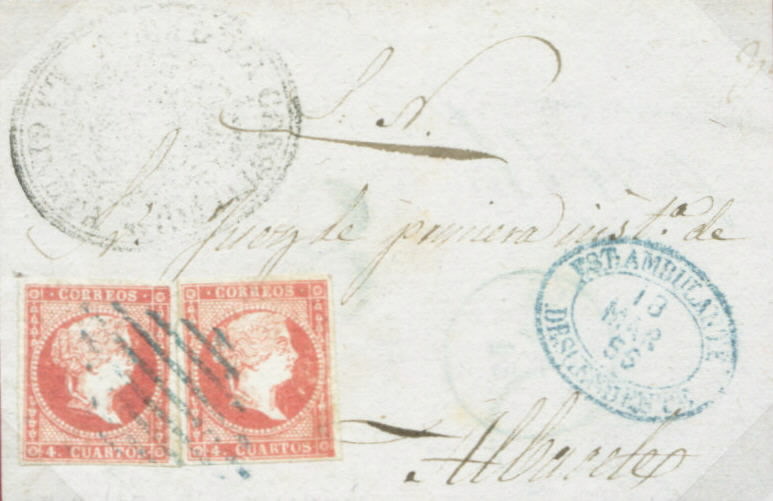
Fig. 1: Est. Ambulante Descendente mark in blue, dated 18 Mar 1856, the first anniversary of the inauguration of the line.
Early TPO marks were oval and then circular, followed by octagonal:
- Oval ambulante: 1855 - 1868 (Fig. 1)
- 20mm - 22mm Small circles: 1857 - 1870
- 27mm - 29mm Large circles: 1874 - 1882, overlapping the Octagonal ambulante by 4 years.
Octagonal ambulante: This mark came into use in 1881 and lasted for approximately 100 years. The communication which authorised the use of these stamps was made in 1878 and some examples from that date have been seen. (Fig 2)
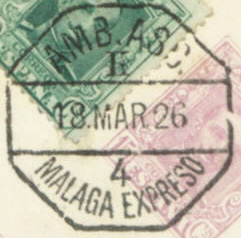
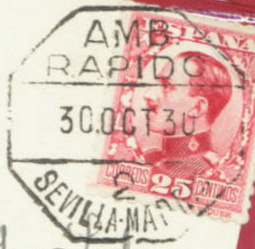
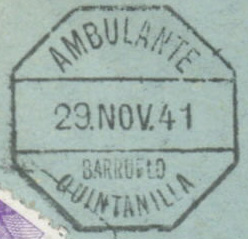
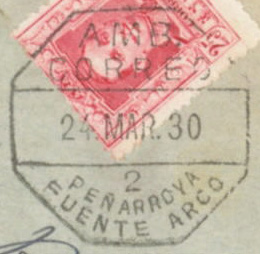
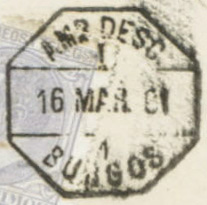
Fig. 2: A range of octagonal ambulante marks.
The Administrators were responsible for the care and custody of the stamps, their boxes and inkpots, and had to pay 34 pesetas if any stamp was lost or spoiled. The general shape of the octagonal stamps has remained consistent with a few minor size changes.
Information given on the Octagonal Marks
| BUZON | POST BOX |
| BUZON ALCANCE | LATE POSTING BOX |
| CORREO CERTIFICADO | REGISTERED MAIL |
| CORREO | Conventional trains with three classes of carriage which carried mail/passengers. |
| EXPRESO | Train with a limited number of stops, travelling at night, sometimes with sleeping compartments. When these have an Estafeta Ambulante coach the octagonal postmarks usually state the type of train. |
| MIXTO | The same as a Correo. |
| OMNIBUS | Local trains stopping at all stations, some trains had estafetas. |
| TREN POSTAL | Exclusively for the carriage of mail. This has appeared since 1970. |
| RAPIDO | Fairly fast train with first and second class carriages travelling during the day with a limited number of stops. |
Four sources of mail passed through the hands of the Estafeta Ambulante staff.
- Mail which had been collected by the Administrator and Assistants from the Main Post Office, and which they had sorted there for the first few stations on the itinerary. The later stations on the route were left to be sorted on the journey. THIS MAIL WAS CANCELLED WITH NORMAL DATE STAMPS.
- Mail posted in the villages and towns along the route. These were bundled together by the local post office staff, CANCELLED WITH THE TOWN DATE STAMP, and taken to the nearest railway station.
- Mail posted in the railway station post box. This was sorted by the visiting or resident postman, cancelled by them and bore ESTACION postmarks. These started from around 1879.
- Mail actually posted in the posting box at the side of the mail coach. THESE LETTERS WOULD BEAR THE AMBULANTE POSTMARKS cancelling the stamps.
Some of the mail sorted on the train, although cancelled earlier, might receive an ambulante cancel as a 'transit' marking. All mail from these sources were sorted in the mail coach and distributed along the route. Later as the volume of mail increased the mail arrived in sacks already sorted and labelled.
Staff
At the top of the staff ladder were the Inspectors whose job it was to examine all documents, consignment notes etc at least once a month. He was responsible for the smooth running of the system. At least four years experience of a main post office was the qualification for the job. Beneath the Inspectors, and with at least three years experience in a main post office were the Administrators, they were in charge of separate ambulante services. Auxiliaries or assistants came last in the pecking order with a two year main office qualification for an assistant 1st class and 1 year for an ordinary assistant.

